 Download PDF
Download PDF
Name: Cuscuta glomerata Choisy
Family: Convolvulaceae, the Morning Glory Family
Common Names: Dodder, rope dodder, glomerate dodder, American dodder, Cluster dodder (2,5,20).
Etymology: With Arabic origins, Kushkut, means dodder plant or parasitic plant; in New Latin, 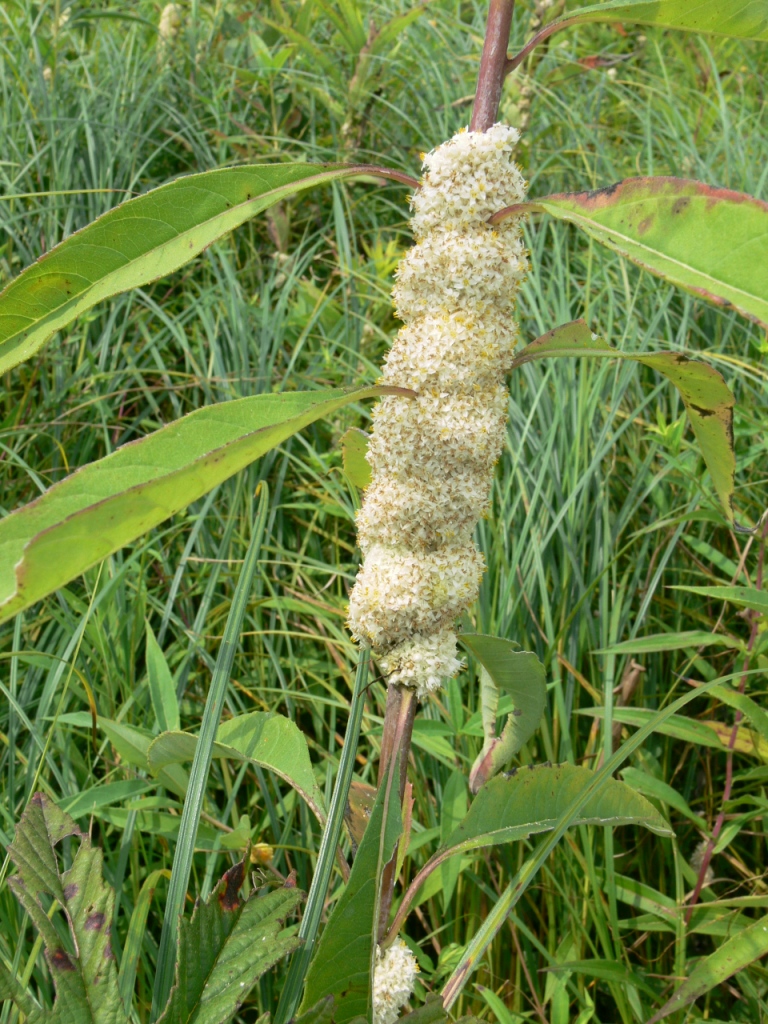 Cuscuta directly translates as dodder. The species name, glomerata, is derived from the Latin word glomeratus, which means dense and round, referring to the inflorescence (16,17).
Cuscuta directly translates as dodder. The species name, glomerata, is derived from the Latin word glomeratus, which means dense and round, referring to the inflorescence (16,17).
Botanical synonyms (1,4):
Lepidanche compositarum Engelm.
Cuscuta paradoxa Raf..
Quick Notable Features (3,4):
¬ Yellow-whitish stem, parasitic with root suckers
¬ Dense cymes that cover the stems when flowering
¬ Nearly sessile flowers bearing free sepals and a style at least twice as long as the ovary
¬ Infrastaminal scales more densely fringed at the apex.
Plant Height: The height of C. glomerata is dependent on the host; H.L. Dean measured the length of a single dodder plant at nearly half a mile (9).
Subspecies/varieties recognized (1):
C. glomerata var. adpressa (Engelm.) Choisy
Most Likely Confused with: Cuscuta indecora, C. cephalanthi, C. coryli, C. polygonorum, C. gronovii, and C. pentagona (2).
Habitat Preference: The glomerate dodder grows mostly on members of the Asteraceae, especially sunflowers (Helianthus) and other tall herbaceous species. C. glomerata is usually found in moist environments like wet to mesic prairies and wetlands (2,3,4,8). McCormac and Windus (21) proposed that reproduction of this species requires prairies fires.
Geographic Distribution in Michigan: C. glomerata is found in Cass and Berrien counties (2).
Known Elevational Distribution: The species was collected at an altitude of 301m in Pettis, MO (1).
Complete Geographic Distribution: Native to North America, the species is found in the central prairie region of the United States: AR, IA, IL, IN, KS, KY, LA, MI, MN, MO, MS, ND, NE, NM, OH, OK, SD, TN, TX, and WI (1,5,21).
Parasitism: Parasitism is a type of symbiotic relationship in which one organism obtains nutrients directly from a host organism. This has a detrimental effect on the host, but benefits the parasite. Although parasitic plants are commonly known to lack chlorophyll, some species have green organs, making them partially photoautotrophic. The physical link between the parasite and the host is called a “haustorium,” and often occurs through xylem-to-xylem attachment. The host can vary, ranging from the mycorrihizae of trees, to grasses and hardwood trees. The parasite often maintains open or partially open stomata, allowing transpiration to aid in extracting nutrients from the host (14).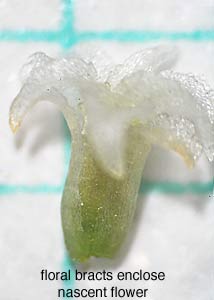
Vegetative Plant Description: As Cuscuta species germinate, they develop a short anchorage root, while a stem forms and nutates (rotates) in search of a host. When an attachment with a host has been created, the anchorage root dies (15). Additional means of finding a host have been suggested in the literature, such as positive photoautotrophy, or growth toward a source of moisture or specific chemicals (10). The stems of C. glomerata are slender, filiform, and yellow to whitish; they coil around the host plant in a dextral orientation. Leaves are absent, instead there are very small, alternate scales (3,4,18).
Flower Description: The inflorescences are very dense cymose heads (glomerules) bearing sessile, white to yellowish flowers (3-6 mm long). The inflorescence is so densely clustered that it covers the stems. Eight to fifteen bracts enclose the flowers; like the five free sepals, they are very thin, oblong to lanceolate, apically spreading, and recurved. The corolla is 5-lobed; the lobes are narrower than the bracts and sepals, apically acute, spreading, and persistent. The infrastaminal scales are fringed, more so at the apex. Five epipetalous stamens are subtended by the scales. The superior ovary is flask-shaped and 2-locular, the 2 distinct styles are at least twice as long as the ovary, the stigmas are capitate (2,3,4).
Flowering Time: July-September (3).
Pollinator: Yuncker observed visits by wasps and other species of the order Hymenoptera to species of Cuscuta (11).
Fruit Type and Description: The fruit is an indehiscent flask-shaped capsule, the remains of the corolla at the apex. Each capsule bears up to 4 seeds (3,4).
Seed Description: In the genus Cuscuta, all species lack cotyledons in the mature embryo. This may derive from the fact that the first job of the young stem is to search for a host, not to photosynthesize. Each ovary bears four ovules, but one or more may abort, which causes variation in seed size and shape; a dodder seed may have zero, one, or two flat surfaces. C. glomerata seeds are about 1.7mm long (3,10).
Dispersal Syndrome: In unspecified members of the genus Cuscuta both germination in the capsule and seeds falling to the ground were observed, leaving water dispersal or other means a possibility for dispersal. Additionally, Cuscuta spp. seeds may be able to pass through the intestinal tract of a sheep intact, remaining viable. Although this method of dispersal is unlikely, it extends the potential dispersal mechanisms to include zoochory (10).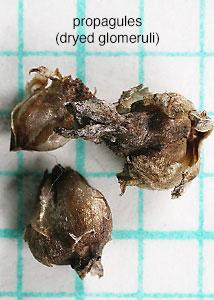
Distinguished by: C. epithymum stems are red, not yellow like in C. glomerata; and it bears pink to red flowers with slender stigmas, not white to yellowish with capitate stigmas as in C. glomerata, the fruit is circumscissile in C. epithymum, while in C. glomerata it is indehiscent. All Cuscuta spp. listed below have bractless flowers with gamosepalous calices, while C. glomerata sepals are enclosed by bracts and separate. C. cephalanthi, C. coryli, and C. polygonorum are 4-merous, C. glomerata is 5-merous. The corolla lobes in C. gronovii are apically rounded, not acute like in C. glomerata. C. indecora has papillate petals and the flowers are pedicellate, while C. glomerata’s flowers are sessile. C. pentagona’s flowers are smaller (up to 2.5mm long) and short pedicellate (2,3).
Other members of the family in Michigan (number species): Calystegia (5), Convolvulus (1), Cuscuta (8), and Ipomoea (4) (source 2).
Ethnobotanical Uses: Native Americans use C. glomerata as aphrodisiac (19). The following information is for unspecified members of Cuscuta. “An Indian proverb states that the person finding the root of dodder will have access to all the riches of the earth” (10). This statement pertains to the wide use of Cuscuta spp. for medicinal purposes across Asia, from herbal mixtures to treat ovarian cancer and postmenopausal osteoporosis to antifungal and insecticidal applications (13). From another perspective, “The dodder’s rapid development and its stranglehold on and damage to the host have earned it a place in the superstition of many Western countries. The German “Teufelsxwirn” and Dutch “Duivelsnaaigaren” are vernacular names of this sort,” highlighting Cuscuta’s standing as a noxious weed in many places (10).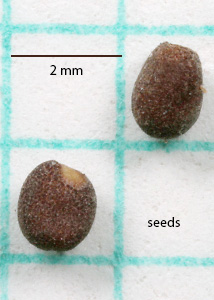
Phylogenetic Information: Convolvulaceae is among the five families of the order Solanales (Montiniaceae, Sphenocleaceae, Hydroleaceae, and Solanaceae), which encompasses 165 genera and 4,080 species. The distribution of Convolvulaceae is extensive worldwide, excluding areas of extreme temperatures—the Sahara and Gobi Deserts, and areas of high latitude (Canada, Greenland, Russia, Antarctica, and Patagonia in South America). Convolvulaceae has been noted as the only Asterid I family whose seeds exhibit physical dormancy (10). Cuscuta spp., belonging to the subfamily Cuscutoideae, is the only genus within the family that is parasitic. Its placement in Convolvulaceae is openly debated, but is supported by similar flower morphology (10,11,12) as well as the twining habit.
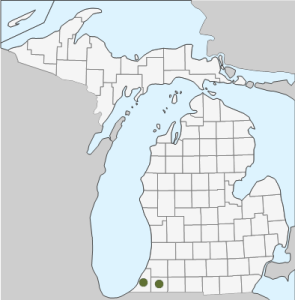 Interesting Quotation or Other Interesting Factoid not inserted above: Some sources place the genus Cuscuta in its own family, Cuscutaceae (4,5). As with other members of the genus Cuscuta, this species may be considered a noxious weed in the United States, yet it is threatened in Ohio and special concern in Wisconsin (5,8).
Interesting Quotation or Other Interesting Factoid not inserted above: Some sources place the genus Cuscuta in its own family, Cuscutaceae (4,5). As with other members of the genus Cuscuta, this species may be considered a noxious weed in the United States, yet it is threatened in Ohio and special concern in Wisconsin (5,8).
Literature and websites used:
- Tropicos.org. Missouri Botanical Garden. 28 Nov 2012 <http://www.tropicos.org/Name/8500682>
- Michigan Flora Online. A.A. Reznicek, E.G. Voss, & B.S. Walters. February 2011. University of Michigan. Web. November 28, 2012. http://michiganflora.net/species.aspx?id=854.
- Fernald, M.L. 1950. Gray’s Manual of Botany, 8th ed. New York: American Book Company.
- Britton, N.L. & H.A. Brown 1970. An Illustrated Flora of the Northern United States and Canada: Volume III. New York, NY: Dover Publications, Inc.
- USDA, NRCS. 2012. The PLANTS Database http://plants.usda.gov/java/profile?symbol=CUGL3, 11/28/12). National Plant Data Team, Greensboro, NC 27401-4901 USA.
- Cudney, D.W., S.N. Orloff, & J.S. Reints 1992. An integrated weed management procedure for the control of dodder (Cuscuta indecora) in alfalfa (Medicago sativa). Weed Technology 6(3): 603-606.
- Callizo, J., J. Ruygt, & G. Muth 1998. The Flora of Napa County, California: Cuscuta. Pacific Union College (online). http://www2.puc.edu/Faculty/Gilbert_Muth/Cuscuta.htm
- Division of Forestry, the Endangered Resources Fund & the Wisconsin Rare Plant Preservation Fund 2012. Endangered Resources: Rope dodder (Cuscuta glomerata). DNR, Wisconsin. dnr.wi.gov/topic/EndangeredResources/Plants.asp?mode=detail&SpecCode=PDCUS010S0
- Dean, H.L. 1942. Total length of stem developed from a single seedling of Cuscuta. Proc. Iowa Acad. Sci. 49: 127–128.
- Kuijt, J. 1969. The Biology of Parasitic Flowering Plants. Los Angeles, CA, USA: University of California Press.
- Yuncker, T.G. 1920. Revision of the North American and West Indian Species of Cuscuta. Illinois Botanical Monographs. 6(2&3):1-141.
- Olmstead, R.G. & S. Stefanović 2004. Testing the phylogenetic position of a parasitic plant (Cuscuta, Convolvulaceae, Asteridae): Bayesian inference and the parametric bootstrap on data drawn from three genomes. Systematic Biology 53(3): 384-399.
- Costea, M. & T.J. François 2005. The biology of Canadian weeds. 133. Cuscuta campestris Yuncker, C. gronovii Willd. ex Schult., C. umbrosa Beyr. ex Hook., C. epithymum (L.) L. and C. epilinum Weihe. Canadian Journal of Plant Science. 298.
- Clark, W.D., R. Moore, & K.R. Stern 1995. Botany. Dubuque, Iowa: Wm. C. Brown Publishers.
- Menninger, E.A. 1970. Flowering Vines of the World. New York, NY: Hearthside Press Inc.
- Brown, R.W. 1956. Composition of Scientific Words. Washington, D.C.: Smithsonian Institution Press.
- Stearn, W.T. 1972. Stearn’s Dictionary of Plant Names for Gardeners. New York, NY: Sterling Publishing Co. Inc.
- Marquardt, E.S. 2009. Foraging and host use of the parasitic plant Cuscuta indecora. Doctoral Thesis/Dissertation: University of Houston. http://gradworks.umi.com/33/71/3371162.html
- Johnson, T. 1999. CRC Ethnobotany Desk Reference. Boca Raton, Florida: CRC Press LLC.
- Zen’s WNV Nature Notebook http://www.main.nc.us/naturenotebook/plants/dodder.html
- McCormac, J.S. & J.L. Windus 1993. Fire and Cuscuta glomerata Choisy in Ohio: a connection? Rhodora 95(882):158-165.
Image Credits (all used with permission):
1. Image of habit courtesy of Jim McCormac, from http://jimmccormac.blogspot.com/
2. Image of stems courtesy of R. Lutz for Iowa Plants, from http://iowaplants.com/
3. Image of flower courtesy of R. Lutz for Iowa Plants, from http://iowaplants.com/
4. Image of flower courtesy of R. Lutz for Iowa Plants, from http://iowaplants.com/
5. Image of fruits courtesy of R. Lutz for Iowa Plants, from http://iowaplants.com/
6. Image of seeds courtesy of R. Lutz for Iowa Plants, from http://iowaplants.com/
7. Species distribution map, derived from the Michigan Flora Online.
Primary Authors: Cristine V. Santanna, Lauren Sopher, and John Bradtke, with revisions and editing by Robyn J. Burnham.
© Robyn J. Burnham
For additional information on Michigan Plant Diversity species accounts, please contact Robyn J. Burnham via email: rburnham“at”umich.edu